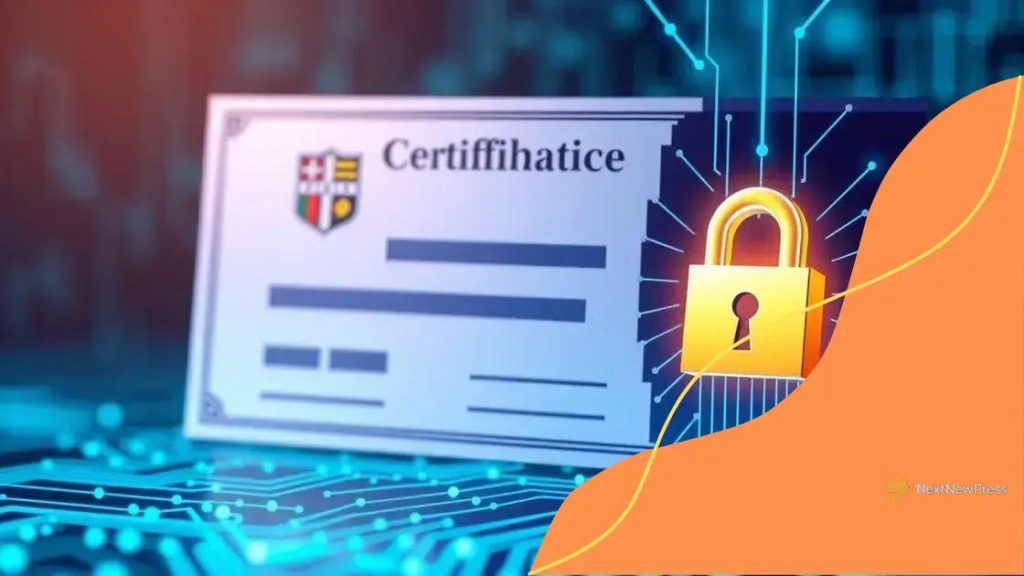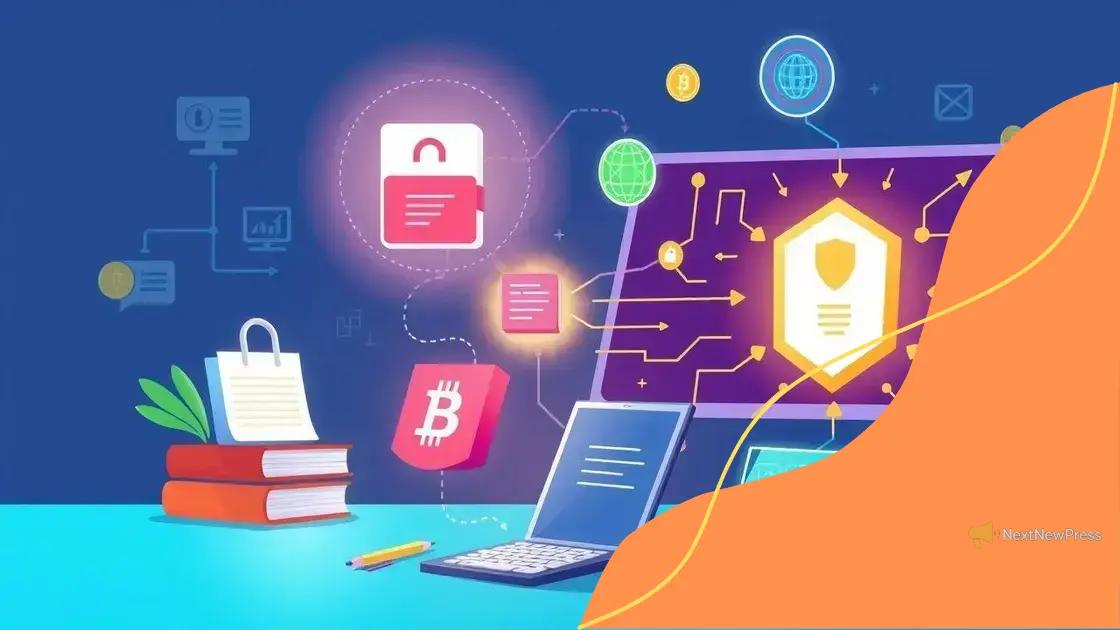The role of blockchain in securing educational credentials

The role of blockchain in securing educational credentials ensures that qualifications are tamper-proof, easily verifiable, and provide students with control over their achievements, thus enhancing security and trust in the education system.
The role of blockchain in securing educational credentials is a fascinating topic that affects students and institutions alike. Have you ever wondered how this technology ensures that your qualifications are protected? Let’s dive into the details.
Understanding blockchain technology
Understanding blockchain technology is essential in today’s digital age, especially in the context of education. This technology offers a new way to secure and verify credentials. But what exactly does it entail? Let’s explore the fundamentals.
What is Blockchain?
At its core, blockchain is a distributed ledger system. It enables multiple parties to maintain a shared and immutable record of transactions. This means that once data is recorded on the blockchain, it cannot be altered without consensus from the network.
Key Features of Blockchain
- Decentralization: Unlike traditional databases, blockchain does not rely on a central authority. This enhances security and transparency.
- Security: Transactions on the blockchain are encrypted, making it nearly impossible for unauthorized parties to alter data.
- Transparency: All participants in the network can view transactions, fostering trust among stakeholders.
One significant aspect of blockchain is its ability to enhance security in educational credentials. By using blockchain technology, institutions can issue verified degrees and certificates that are tamper-proof. This eliminates the risks associated with fraudulent qualifications.
Moreover, blockchain technology facilitates real-time verification. Employers can quickly check a candidate’s credentials through a secure and transparent process. This not only saves time but also increases the overall trust in the hiring process.
The Importance of Smart Contracts
Another interesting feature of blockchain is the use of smart contracts. These are self-executing contracts with the terms of the agreement directly written into code. In education, smart contracts can automate processes, such as issuing diplomas once a student meets all academic requirements.
In conclusion, understanding blockchain technology is crucial for recognizing its potential impact on the education sector. As more institutions adopt this technology, we can expect enhanced security, efficiency, and trust in educational credentials.
Benefits of using blockchain for credentials
The benefits of using blockchain for credentials are significant and can transform how educational qualifications are verified. One major advantage is security. Blockchain technology ensures that once a credential is issued, it cannot be changed or tampered with.
Increased Security
Because each record on the blockchain is encrypted and linked to previous transactions, it becomes extremely difficult for fraudsters to alter or counterfeit documents. This level of security builds trust with employers and educational institutions.
Efficiency in Verification
Another key benefit is the efficiency it offers in verifying credentials. Traditional methods can take time and involve multiple steps. However, with blockchain, employers can instantly verify a candidate’s educational background without contacting each institution.
- Time-saving: Instant verification speeds up the hiring process.
- Cost-effective: Reduces the need for background checks through third parties.
- Streamlined processes: Automates verification and reduces paperwork.
Moreover, the transparency provided by this technology allows all parties involved to view the same records. This means that students, employers, and institutions have access to the same verified information, making the process fairer and more straightforward.
Empowerment of Graduates
Using blockchain also empowers graduates. They can control their own records and share them as needed. This self-sovereignty gives them more confidence in their credentials.
Additionally, blockchain can be integrated with digital wallets, allowing students to carry their verified credentials securely. This innovation enables them to present their qualifications whenever necessary without the risk of lost or stolen documents.
In summary, the benefits of using blockchain for credentials not only enhance security but also bring efficiency and empowerment to graduates. As more institutions adopt this technology, we can expect a more reliable and trustworthy process for verifying educational achievements.
How blockchain enhances security in education

How blockchain enhances security in education is a critical concept in today’s digital world. With an increasing number of educational institutions moving online, protecting sensitive information has never been more vital. Blockchain technology offers advanced security features that set it apart from traditional methods.
Immutable Records
One of the main ways blockchain enhances security is through its immutable record-keeping. Once a student’s information is entered into the blockchain, it cannot be altered or deleted. This ensures that all credentials are permanent and reliable.
Enhanced Data Privacy
Blockchain technology also provides enhanced data privacy. Unlike traditional databases, which often store personal information in central locations, blockchain distributes data across a network. This decentralized approach makes it difficult for hackers to target and access sensitive information.
- Encryption: All data is encrypted, adding an extra layer of protection.
- Access control: Only authorized individuals can access student records.
- Anonymity: Students can maintain some level of anonymity while sharing their achievements.
Moreover, the transparency of blockchain means that any changes or transactions are easily traceable. This feature can help educational institutions identify any unauthorized attempts to alter records. It fosters trust among students, parents, and employers who rely on these credentials.
Smart Contracts in Education
Smart contracts further enhance security in education. These self-executing contracts automatically enforce rules and agreements. For example, a smart contract might automatically issue a diploma when a student meets all necessary requirements. This process reduces the risk of errors and fraudulent claims.
In addition, smart contracts provide a clear, verifiable record of transactions, ensuring transparency. This can significantly enhance the integrity of educational institutions and the validity of their certifications.
Overall, understanding how blockchain enhances security in education reveals its potential to create a safer, more reliable environment for both students and educators. As more institutions embrace this technology, the academic landscape will become increasingly secure.
Case studies of blockchain in educational institutions
Case studies of blockchain in educational institutions provide real-world examples of how this technology is transforming education. Institutions around the globe are beginning to adopt blockchain for various functions, leading to improved processes and enhanced security.
MIT Media Lab
The Massachusetts Institute of Technology (MIT) has been at the forefront of implementing blockchain technology for educational credentials. In 2017, MIT launched a project to issue digital diplomas using blockchain. This initiative allows graduates to easily share their verified credentials with employers, all while maintaining control over their personal data.
University of Melbourne
Another notable case study comes from the University of Melbourne. They partnered with an online learning platform to experiment with blockchain technology for issuing certificates. By using blockchain, the university ensures that the certificates are tamper-proof and can be verified instantly by employers or other institutions.
- Immediate Verification: Employers can quickly validate a graduate’s credentials without extensive background checks.
- Reduced Fraud: Makers of fake degrees have a much harder time producing a counterfeit document.
- Improved Trust: Both students and employers can trust the integrity of the documents.
Furthermore, the University of Nicosia in Cyprus offers certificates for their online courses on the blockchain. This innovative approach allows students to receive proof of their achievements instantly and securely. The institution has found that using blockchain for educational certificates increases student satisfaction, as it simplifies the verification process.
Open University
The Open University in the United Kingdom is also exploring the benefits of blockchain technology. They are testing a system that enables students to store and share their academic achievements securely. This pilot program aims to empower learners by giving them greater control over their educational records.
As more educational institutions adopt blockchain, it becomes clear that these case studies illustrate the potential of this technology. From securing credentials to enhancing the verification process, blockchain is changing the landscape of education in meaningful ways.
Future trends in blockchain and education
Future trends in blockchain and education are exciting and full of potential. As technology advances, we can expect significant changes in how educational institutions utilize blockchain to improve processes and enhance learning. One of the most promising trends is the widespread adoption of digital credentials.
Widespread Digital Credentials
More universities and colleges are likely to adopt digital credentials verified by blockchain technology. These credentials provide a secure way for students to share their qualifications with potential employers or other institutions. This trend enhances the visibility of students’ achievements while simplifying the verification process.
Micro-Credentials and Lifelong Learning
Another key trend involves the rise of micro-credentials. These are shorter, skill-based certifications that recognize specific competencies. Blockchain can securely store and manage these micro-credentials. As the job market evolves, lifelong learning becomes crucial. Micro-credentials will allow students to continuously update their skills.
- Flexibility: Students can earn credits at their convenience.
- Personalization: Learners can tailor their education to match career goals.
- Real-Time Updates: Credentials can be updated instantly on the blockchain.
Additionally, we might see blockchain integrated with artificial intelligence (AI) to enhance personalized learning experiences. By analyzing student data, AI can help tailor educational pathways and provide recommendations for courses or resources. This integration can lead to a more effective, individualized learning experience.
Collaborative Certifications
Many institutions may also explore collaborative certifications. In this model, multiple educational entities can work together to offer accredited programs that leverage each other’s strengths. Blockchain can streamline the process by ensuring that all institutions involved maintain transparent records of student achievements.
As these trends develop, the role of blockchain in education is set to expand. With improved security, efficiency, and personalization, the future of education could be significantly impacted. We can expect innovations that not only enhance the learning experience but also prepare students for the rapidly changing job market.
In conclusion, the integration of blockchain technology in education is reshaping how institutions manage credentials and enhance learning. As digital credentials gain traction, students can benefit from secure and verifiable qualifications. The rise of micro-credentials allows for a more flexible and personalized learning experience, enabling continuous skill development. Furthermore, collaboration among educational institutions will lead to innovative certifications that leverage the strengths of multiple entities. As we look to the future, blockchain will play a critical role in making education more accessible, secure, and efficient.
FAQ – Questions About Blockchain in Education
How does blockchain improve the security of educational credentials?
Blockchain makes educational credentials secure by ensuring they cannot be altered once issued. Each record is encrypted and linked, preventing fraud.
What are digital credentials?
Digital credentials are electronic versions of educational qualifications that can be easily shared and verified, enhancing the convenience for students and employers.
What are micro-credentials and why are they important?
Micro-credentials are short, skill-based certifications that recognize specific competencies. They are important for continuous learning in a rapidly changing job market.
Can multiple institutions collaborate on certifications using blockchain?
Yes, blockchain allows educational institutions to collaborate on certifications, enabling shared records and enhanced credibility for combined programs.





